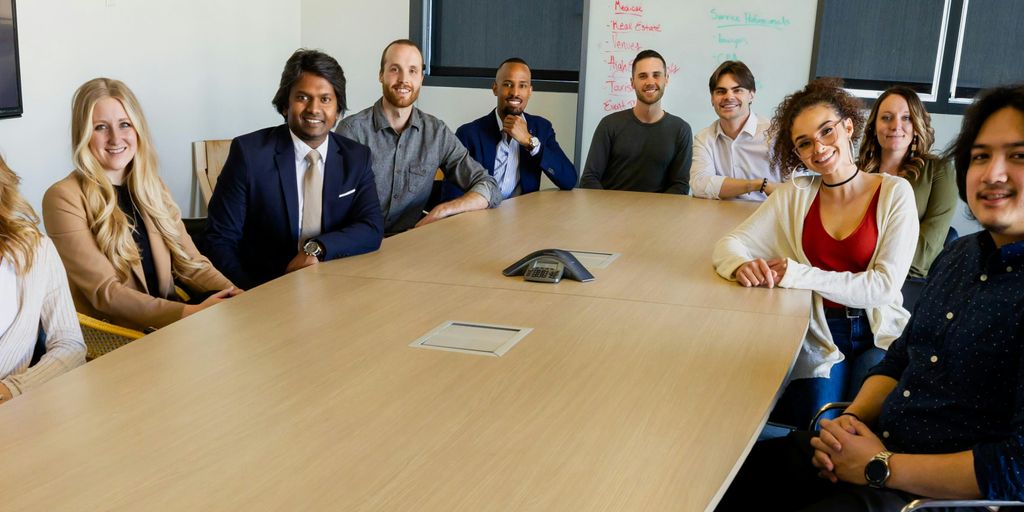This article is all about essential leadership topics for discussion. It’s a guide to help you lead your team to success. We’ll look at different ways to help your team work better and achieve more. It’s important to talk about these things to make sure everyone is on the same page and moving forward together.
Key Takeaways
- Good communication is super important for leaders and for teamwork.
- Building a strong team helps everyone feel good about their work and get more done.
- Knowing how to handle disagreements helps keep the team working well together.
- Letting team members take on more tasks helps them grow and feel responsible.
- Coming up with new ideas and trying new things is key to staying ahead and doing well.
Cultivating a Shared Vision and Clear Goals
It’s easy for teams to drift without a clear direction. That’s why establishing a shared vision and well-defined goals is so important. It’s like giving everyone a map and a destination. When everyone knows where they’re going, they’re more likely to get there together.
Articulating a Compelling Vision
A leader needs to paint a picture of the future that excites and motivates the team. It’s not enough to just say, "We want to be number one." You have to explain why being number one matters and what it will mean for everyone involved. Think of it as telling a story that everyone wants to be a part of. It should connect with their values and aspirations. It’s about creating a sense of purpose that goes beyond just showing up for work. This helps with team productivity.
Collaborative Goal Setting
Goals shouldn’t be handed down from on high. The best goals are created together. When team members are involved in the goal-setting process, they’re more likely to buy in and take ownership. It’s about having open discussions, brainstorming ideas, and making sure everyone’s voice is heard. This also means making sure the goals are realistic and achievable. Here’s a simple way to think about it:
- Discuss overall objectives.
- Brainstorm specific, measurable goals.
- Assign responsibilities and deadlines.
Mentoring for Goal Achievement
Setting goals is one thing, but actually achieving them is another. That’s where mentoring comes in. Leaders should act as mentors, providing guidance, support, and resources to help team members stay on track. This could involve regular check-ins, offering advice, or connecting team members with other experts. It’s about creating a culture of continuous learning and development, where everyone feels empowered to reach their full potential. Mentoring can also help with setting and prioritizing goals.
Mastering Effective Communication Skills
Communication, it’s not just talking, right? It’s about making sure everyone’s on the same page. I think leaders really need to nail this skill if they want their teams to actually, you know, work.
Clarity in Conveying Ideas
Ever been in a meeting where you leave more confused than when you walked in? Yeah, that’s a communication fail. It’s on the leader to make sure their message is crystal clear. No jargon, no beating around the bush. Just straight talk. Think of it like this:
- Keep sentences short and to the point.
- Use examples to illustrate complex ideas.
- Ask for feedback to check understanding.
The Power of Active Listening
Listening isn’t just waiting for your turn to talk. It’s about actually hearing what the other person is saying. Like, really hearing. Pay attention to their body language, their tone, everything. It shows you care, and honestly, you might learn something. Active listening is a variety of communication skills that can help you understand the perspectives of others. Here’s how I try to do it:
- Maintain eye contact.
- Nod and use verbal cues like "I see" or "Tell me more."
- Summarize what they said to confirm you understood correctly.
Delivering Constructive Feedback
Nobody likes getting negative feedback, but it’s gotta happen sometimes. The key is to make it constructive. Focus on the behavior, not the person. And always, always offer solutions. I try to follow these guidelines:
- Be specific about what they did well and what needs improvement.
- Frame it as an opportunity for growth.
- Offer support and resources to help them improve. Effective leadership skills are crucial for making a greater impact within a community.
Building Strong Team Dynamics and Trust
Team dynamics? It’s all about how well your team works together. And trust? That’s the glue that holds everything together. Without trust, you’ve got nothing. It’s like trying to build a house on sand. A team that trusts each other is a team that can conquer anything.
Fostering an Environment of Trust
So, how do you actually build trust? It’s not something that happens overnight. It takes time, effort, and a genuine commitment from everyone involved. One thing that helps is making sure everyone feels safe to speak up. No one wants to share ideas if they think they’ll get shot down. You also need to be reliable. Do what you say you’re going to do. People notice when you don’t. And be open. Share information, even when it’s not easy. Transparency builds team building activities.
Open Communication Channels
Communication is key. I mean, duh, right? But it’s not just about talking. It’s about listening. Really listening. Make sure everyone has a chance to speak, and that their voices are heard. Encourage people to share their thoughts and ideas, even if they’re different from yours. And don’t be afraid to have tough conversations. Avoiding conflict doesn’t make it go away; it just festers. Here are some ways to improve communication:
- Use clear and concise language.
- Actively listen to what others are saying.
- Provide regular updates and feedback.
Strategies for Conflict Resolution
Conflict is inevitable. It’s going to happen. The key is to have strategies in place to deal with it when it does. Don’t let it escalate. Address it early and head-on. Encourage people to talk to each other directly. Facilitate conversations and help them find common ground. Sometimes, you might need to mediate. But the goal is always to find a solution that works for everyone. Remember that effective conflict resolution strategies are important. Here’s a simple process:
- Acknowledge the conflict.
- Understand different perspectives.
- Find common ground and solutions.
Empowering Team Members Through Delegation

Delegation is more than just dumping tasks on your team. It’s about growing their skills and freeing up your time for bigger-picture stuff. I used to think I had to do everything myself to make sure it was done right, but I learned the hard way that it’s a recipe for burnout. Now, I try to delegate as much as possible, and it’s made a huge difference.
Delegating for Growth and Accountability
Delegation isn’t just about offloading work; it’s about giving your team members opportunities to learn and grow. When you delegate effectively, you’re showing trust in their abilities and giving them a chance to develop new skills. This also creates a sense of accountability, as they’re responsible for the outcome of the task. It’s a win-win. I remember when I first delegated a project to Sarah, she was nervous, but she totally crushed it. It boosted her confidence and showed me that I could trust her with more responsibility. It’s important to provide the necessary resources for the team.
Identifying Strengths for Task Assignment
Not everyone is good at everything. That’s why it’s important to know your team members’ strengths and weaknesses when delegating tasks. If someone is detail-oriented, they might be a good fit for a task that requires accuracy. If someone is creative, they might be better suited for a task that requires brainstorming. It’s about playing to people’s strengths. Here’s a quick guide I use:
- Assess Skills: Regularly evaluate team members’ skills through performance reviews and informal check-ins.
- Observe Performance: Pay attention to which tasks team members excel at and enjoy.
- Consider Interests: Whenever possible, align tasks with team members’ interests to increase engagement and motivation.
Providing Support and Guidance
Delegating doesn’t mean abandoning your team members. It’s important to provide support and guidance along the way. This could mean answering questions, providing feedback, or offering resources. The goal is to help them succeed, not to set them up for failure. I always make sure to check in with my team members regularly when they’re working on a delegated task. I don’t want to micromanage, but I want them to know that I’m there if they need me. It’s about finding the right balance between autonomy and support.
Driving Innovation and Creative Problem-Solving
Innovation is super important. It helps companies stay competitive and adapt. Leaders need to make a space where new ideas are welcome. It’s not just about thinking up new stuff, but also making it happen.
Encouraging New Ideas
Leaders should actively encourage their teams to come up with new ideas. This means creating a safe space where people aren’t afraid to share even the craziest thoughts. Think brainstorming sessions, suggestion boxes (digital ones, of course!), and just generally being open to hearing people out. It’s also about valuing different ways of thinking and promoting open-mindedness.
Fostering a Culture of Experimentation
Experimentation is key. Not everything will work, and that’s okay. The important thing is to learn from failures. Leaders can support this by providing resources and time for team members to explore creative solutions. Maybe set aside a specific day or time each week for experimentation. Or, create a small budget for trying out new things. It’s about emphasizing the importance of experimentation and learning from successes and failures.
Overcoming Creative Blocks
Everyone hits a wall sometimes. When that happens, it’s helpful to have some strategies for getting unstuck. This could involve things like:
- Taking a break and doing something completely different
- Talking to someone else about the problem
- Trying a different approach
- Looking at the problem from a new angle
Leaders can also help by providing resources and support. Maybe offer corporate soft skills training or workshops on creative problem-solving. The goal is to help team members develop the skills and confidence they need to overcome creative blocks and keep innovating.
Developing Coaching and Mentoring Capabilities
So, you want to be a better coach and mentor? It’s not just about telling people what to do; it’s about helping them grow. Think of it as planting seeds and helping them sprout. It’s about guiding your team, not dictating to them.
Guiding Through Expert Guidance
Being a guide means sharing what you know, but more importantly, helping others figure things out for themselves. It’s like being a GPS, not driving the car. You’re providing direction, not taking over. This involves offering advice, sharing experiences, and helping team members see different perspectives. It’s also about knowing when to step back and let them learn from their mistakes. Think of it as leadership coaching – helping people develop their own skills.
Creating Personalized Development Plans
One size doesn’t fit all. Everyone has different strengths, weaknesses, and goals. A personalized plan acknowledges these differences. It’s like tailoring a suit – it needs to fit just right. This involves:
- Identifying individual skills and areas for improvement.
- Setting specific, achievable goals together.
- Providing resources and support tailored to their needs.
It’s not about forcing someone into a mold; it’s about helping them become the best version of themselves. Setting REAL goals is important for mentoring relationships.
Tracking Progress and Providing Feedback
How do you know if you’re making progress? You need to track it. This isn’t about micromanaging; it’s about providing support and accountability. Regular check-ins, feedback sessions, and personalized learning are key.
- Set clear milestones.
- Offer regular, constructive feedback.
- Adjust the plan as needed.
Think of it as a continuous loop of learning and improvement. It’s not about perfection; it’s about growth. Kudos for positive feedback can be a great tool here.
Inspiring and Influencing Team Performance
Leading by Example
Okay, so, leading by example. It sounds super cliché, right? But honestly, it’s huge. I mean, think about it: if you’re slacking off, showing up late, and generally not caring, why would your team do any different? Your actions speak way louder than any motivational speech you could give. It’s about showing them what’s expected through your own behavior. I try to be the first one in and the last one out sometimes, just to show I’m committed. It’s not about being a martyr, but about setting the tone. I also try to own up to my mistakes. Nobody’s perfect, and admitting when you mess up shows you’re human and creates a more honest environment. It’s a small thing, but it makes a difference. You can also maintain integrity by being honest and transparent.
Motivating and Engaging Employees
Keeping people motivated is a constant battle, isn’t it? What works for one person might totally bomb with another. I’ve found a few things that seem to help, though. First, recognition. People want to know their work matters. A simple "thank you" or highlighting a job well done in a meeting can go a long way. Also, growth opportunities are key. Nobody wants to feel stuck in a dead-end job. Offering training, workshops, or even just a chance to take on new responsibilities can keep people engaged. And let’s not forget the importance of a positive work environment. No one wants to come to work if it’s a toxic, stressful place. I try to keep things light, encourage collaboration, and make sure everyone feels like their voice is heard. It’s not always easy, but it’s worth the effort. Here’s a quick breakdown of some motivational tactics:
- Recognition: Public praise, small rewards, thank-you notes
- Growth: Training, new projects, mentorship programs
- Environment: Positive culture, open communication, team-building activities
Building a Positive Team Culture
Team culture… it’s one of those things that’s hard to define but you definitely know when it’s missing. A good culture is like the glue that holds everything together. It’s about creating a space where people feel comfortable, supported, and valued. I try to encourage open communication, where everyone feels safe sharing ideas and concerns. Team-building activities, even if they seem cheesy, can actually help people connect on a personal level. And celebrating successes, big or small, is crucial for boosting morale. It’s also important to address conflict head-on. Ignoring problems just lets them fester and can poison the whole atmosphere. It’s about creating a culture of respect, where people can disagree without being disagreeable. I’ve found that personal, authentic and human connections are key to building a strong team culture.
Conclusion
So, talking about leadership stuff with your team is a pretty big deal for making things better at work. When you have these chats, people get better at what they do, get along more, and work together for the same goals. These talks help everyone learn new things, work together, and become good leaders themselves. If leaders keep these topics in mind, they can help their teams grow, come up with new ideas, and do well. Doing these discussions often can help everyone keep getting better, both as individuals and as a team.
Frequently Asked Questions
Why are Vision and Goal Setting important in leadership talks?
Having a clear vision and setting goals helps leaders guide their team toward a common purpose and achieve success.
How do Communication Skills help teams grow during leadership discussions?
Good communication helps teams work better together, understand each other, and solve problems.
What makes Team Building and Dynamics so important for a group’s success?
Team building creates a safe space where everyone feels comfortable sharing ideas and taking chances, which makes the team stronger.
How does giving tasks to team members help them improve?
Giving team members tasks helps them grow, learn new things, and feel more responsible for their work.
Why is it important to encourage new ideas and creative thinking in a team?
Encouraging new ideas and trying out different ways of doing things helps teams come up with fresh solutions and stay ahead.
What is the role of Coaching and Mentoring in making a team better?
Coaching and mentoring help team members get better at their jobs by giving them personalized guidance and support.














